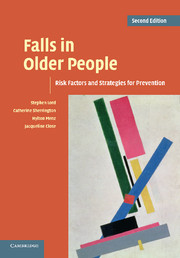Book contents
- Frontmatter
- Contents
- Preface
- Acknowledgements
- Part I Epidemiology and risk factors for falls
- 1 Epidemiology of falls and fall-related injuries
- 2 Postural stability and falls
- 3 Gait characteristics and falls
- 4 Sensory and neuromuscular risk factors for falls
- 5 Psychological factors and falls
- 6 Medical risk factors for falls
- 7 Medications as risk factors for falls
- 8 Environmental risk factors for falls
- 9 The relative importance of falls risk factors: an evidence-based summary
- Part II Strategies for prevention
- Part III Research issues in falls prevention
- Index
- References
2 - Postural stability and falls
Published online by Cambridge University Press: 03 May 2010
- Frontmatter
- Contents
- Preface
- Acknowledgements
- Part I Epidemiology and risk factors for falls
- 1 Epidemiology of falls and fall-related injuries
- 2 Postural stability and falls
- 3 Gait characteristics and falls
- 4 Sensory and neuromuscular risk factors for falls
- 5 Psychological factors and falls
- 6 Medical risk factors for falls
- 7 Medications as risk factors for falls
- 8 Environmental risk factors for falls
- 9 The relative importance of falls risk factors: an evidence-based summary
- Part II Strategies for prevention
- Part III Research issues in falls prevention
- Index
- References
Summary
Postural stability can be defined as the ability of an individual to maintain the position of the body, or more specifically, its centre of mass, within specific boundaries of space, referred to as stability limits. Stability limits are boundaries in which the body can maintain its position without changing the base of support. This definition of postural stability is useful as it highlights the need to discuss stability in the context of a particular task or activity. For example, the stability limit of normal relaxed standing is the area bounded by the two feet on the ground, whereas the stability limit of unipedal stance is reduced to the area covered by the single foot in contact with the ground. Due to this reduction in the size of the stability limit, unipedal stance is an inherently more challenging task requiring greater postural control.
Regardless of the task being performed, maintaining postural stability requires the complex integration of sensory information regarding the position of the body relative to the surroundings and the ability to generate forces to control body movement. Thus, postural stability requires the interaction of musculo-skeletal and sensory systems. The musculo-skeletal component of postural stability encompasses the biomechanical properties of body segments, muscles and joints. The sensory components include vision, vestibular function and somatosensation, which act to inform the brain of the position and movement of the body in three-dimensional space.
- Type
- Chapter
- Information
- Falls in Older PeopleRisk Factors and Strategies for Prevention, pp. 26 - 49Publisher: Cambridge University PressPrint publication year: 2007
References
- 4
- Cited by



